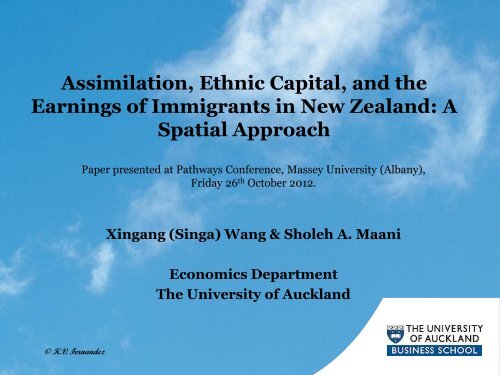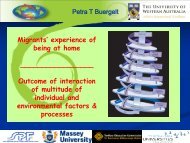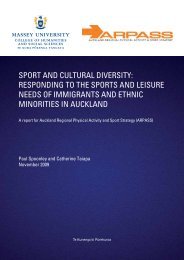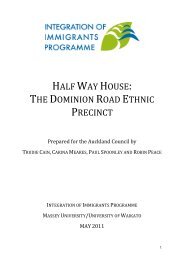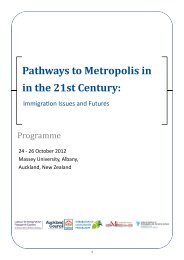view pdf - Integration of Immigrants Programme - Massey University
view pdf - Integration of Immigrants Programme - Massey University
view pdf - Integration of Immigrants Programme - Massey University
You also want an ePaper? Increase the reach of your titles
YUMPU automatically turns print PDFs into web optimized ePapers that Google loves.
Assimilation, Ethnic Capital, and the<br />
Earnings <strong>of</strong> <strong>Immigrants</strong> in New Zealand: A<br />
Spatial Approach<br />
Paper presented at Pathways Conference, <strong>Massey</strong> <strong>University</strong> (Albany),<br />
Friday 26 th October 2012.<br />
Xingang (Singa) Wang & Sholeh A. Maani<br />
Economics Department<br />
The <strong>University</strong> <strong>of</strong> Auckland<br />
© K.V. Fernandez
Outline<br />
• Introduction<br />
--background<br />
--motivation<br />
• Ethnic Capital<br />
• Models: Basic and Spatial Models<br />
• Data<br />
• Empirical Evidence<br />
• Conclusion
Introduction-- Background<br />
• Assimilation is an important indicator which measures<br />
the economic performance <strong>of</strong> immigrants.<br />
• The word “assimilation” refers to the processes along<br />
which an immigrant’s earnings converge to a<br />
comparable native level, after residing in the host<br />
country for a certain period <strong>of</strong> time.
Introduction-- Background<br />
• Disadvantages <strong>of</strong> immigrants in the local labour market<br />
(Chiswick, 1978):<br />
--Lack <strong>of</strong> language skills,<br />
--Absence <strong>of</strong> social networks,<br />
--Less knowledge <strong>of</strong> customs,<br />
--Lack <strong>of</strong> information about the local labour market,<br />
--Lack <strong>of</strong> firm-specific training
Introduction-- Background<br />
• However, economists (e.g. Chiswick,<br />
1978; Borjas, 1991, 1994) hypothesise<br />
that immigrants would be eventually<br />
assimilated.<br />
Because immigrants are:<br />
-- more able and self-motivated<br />
-- work harder and longer<br />
--easy for them to transfer skills<br />
Thus, immigrants’ income grows faster.<br />
Source: Borjas (1994)
Introduction-- Motivation<br />
• New Zealand is a country <strong>of</strong> immigrants.<br />
• Before 1987: “Occupational Priority List” (OPL)<br />
• 1987, “traditional source countries” was replaced by<br />
stream approach<br />
• Immigration Amendment Act 1991: “Point System”<br />
• In 2003, it was supplanted by the “Skilled Migrant<br />
Category” policy<br />
• 2006 Census:<br />
• 22.9% <strong>of</strong> usually residents are foreign born<br />
• 18.9% <strong>of</strong> immigrants are Asian<br />
• 14.4% <strong>of</strong> immigrants are Pacific Islanders
Introduction– New Zealand Case<br />
(hourly earning)<br />
Source: New Zealand Income Survey (2001-2010)
Introduction-- Motivation<br />
• Assimilation processes <strong>of</strong> different ethnic groups happen in<br />
diverse patterns and time ranges (e.g. Chiswick, 1978; Borjas,<br />
1994; Poot, 1993; Winkelmann & Winkelmann, 1998; Card,<br />
2005).<br />
For example, Asian and Pacific Islander immigrants in<br />
New Zealand experience a substantial income disadvantage.<br />
Their assimilation process takes a longer time (e.g. Poot,<br />
1993; Stillman and Mare, 2009; Stillman and Velamuri,<br />
2010).
Introduction-- Motivation<br />
• In addition, previous studies have assumed that<br />
individuals’ labour market performance data is<br />
independent and identically distributed (i.i.d.).<br />
• However, one may consider whether individuals within<br />
ethnic groups influence on each other and their labour<br />
market performance is correlated to some extent.
Introduction-- Motivation<br />
• Core questions:<br />
• Why and how ethnicity is important for immigrants’<br />
assimilation?<br />
• How immigrants’ economic performances are linked<br />
with each other?<br />
• In order to answer these questions related to “ethnicity”<br />
we use “ethnic capital” as a key concept to answer it and<br />
to fill the literature gap.
Ethnic Capital<br />
• Ethnic capital is a form <strong>of</strong> social capital, and it was<br />
first put forward by Borjas (1992) in the context <strong>of</strong><br />
economics <strong>of</strong> immigration.<br />
• Ethnic capital is the inherent trust and advantages<br />
which stem from, and belong to, a certain ethnic group.<br />
As a result, ethnic capital can <strong>of</strong>fset those<br />
disadvantages <strong>of</strong> immigrants to a certain extent.<br />
• It can refer to the average skill level, the language<br />
pr<strong>of</strong>iciency, the average income level, network and the<br />
geographical concentration (ethnic enclave) for an<br />
ethnic group.
Ethnic Capital-network effects<br />
• Proxy for network for immigrants in previous studies:<br />
• Ethnic Concentration/Enclave (e.g. Aguilera, 2009;<br />
Damm, 2009; Edin, Fredriksson, and Aslund, 2003;<br />
Toussaint-Comeau, 2008).<br />
• Linguistic Concentrations (Bertrand, Luttmer, &<br />
Mullainathan, 2000; Chiswick & Miller, 2002).
Ethnic Capital-network effects<br />
• In this study, we construct a spatial network variable--<br />
the endogenous “ethnic spatial lag” ;<br />
• “Ethnic spatial lag” represents the individual’s network <strong>of</strong><br />
economic resources in addition to ethnic concentration<br />
• To separate the spatial network specific effect<br />
• We hypothesize that both ethnic networks and ethnic<br />
concentration influence immigrants’ economic<br />
performance.
Ethnic Capital-Ethnic Network<br />
• Living in a common environment<br />
• Producing shared experiences, knowledge, information<br />
and other products through networks.<br />
• Social networks -“the most pr<strong>of</strong>itable avenue <strong>of</strong> job<br />
search” for immigrants (Frijters, Shields, & Price, 2005).<br />
• Therefore, we hypothesize social networks may act<br />
positively on the process <strong>of</strong> immigrants’ assimilation.
Ethnic Capital-Ethnic Concentration<br />
• More jobs could be generated (“Protected Market”)<br />
• Lowering barriers to employment for immigrants<br />
• So, employment within the ethnic enclave very attractive; but reduces<br />
the bargaining power <strong>of</strong> immigrants<br />
• “Complements” vs. “Substitutes”<br />
• Complement: higher demand for immigrant labour would be generated<br />
• Substitute: compete for scarce employment opportunities<br />
• Previous studies observed both positive (e.g. Edin, Fredriksson, &<br />
Aslund, 2003) and negative (Lazear, 1999) effects <strong>of</strong> ethnic<br />
concentration.
Models-Basic model<br />
• Wi: earnings <strong>of</strong> individual i ;<br />
• Xi: a vector <strong>of</strong> explanatory variables (e.g. years <strong>of</strong><br />
schooling completed, marital status, and years <strong>of</strong><br />
labour market experience);<br />
• ti: years since migration to the host country;<br />
• Ii: a dummy variable set to 1 if person i is an immigrant.<br />
(Borjas, 1985).
Ethnic network- example<br />
Waikato
Ethnic Spatial Matrix
Models-Spatial model (SAR)
Models-Spatial model (SAR)<br />
• Under OLS estimation:<br />
• Anselin (1990), Kelejian and Prucha (1998), and Kelejian<br />
and Robinson (1993) proposed a Spatial Two-Stage Least<br />
Squares (2SLS) approach to control the endogeneity <strong>of</strong><br />
spatial lag and estimate the parameter <strong>of</strong> spatial lag.<br />
• The full set <strong>of</strong> instrumental variables is:
Data<br />
New Zealand Income Survey<br />
• The first release <strong>of</strong> NZIS was on 11 December 1997.<br />
• NZIS contains income respondents’ information on selfemployment,<br />
wages and salaries.<br />
• A merged cross-sectional data set created from 2001 to<br />
2010 NZIS data sets was produced for and adopted in this<br />
study.<br />
• Only observations <strong>of</strong> employed male immigrants and<br />
natives aged 20 and 55 years old have been tested.<br />
• New Zealand-born: 42,259<br />
• <strong>Immigrants</strong>: 12,163
Data summary
Empirical Results<br />
Table 4: OLS Estimates <strong>of</strong> Log Hourly Wage: Employed Male in New Zealand, age 20-<br />
55, 2001-2010, NZIS<br />
Pooled Sample<br />
Natives<br />
Foreign-Born<br />
Human Capital<br />
Potential Experience 0.033*** 0.033*** 0.037***<br />
(0.001) (0.001) (0.002)<br />
Potential Experience -squared -0.001*** -0.001*** -0.001***<br />
(0.00002) (0.00002) (0.00004)<br />
High School Qualification 0.179*** 0.181*** 0.174***<br />
(0.009) (0.01) (0.025)<br />
Vocational Qualification 0.193*** 0.193*** 0.191***<br />
(0.004) (0.005) (0.011)<br />
<strong>University</strong> Degree 0.492*** 0.524*** 0.423***<br />
(0.005) (0.006) (0.011)<br />
Other Post School Qualification 0.174*** 0.174*** 0.162***<br />
(0.009) (0.011) (0.017)<br />
Personal Characteristics<br />
Years Since Migration (YSM) 0.006*** / 0.012***<br />
(0.001) / (0.002)<br />
YSM-squared -0.0001*** / -0.0002***<br />
(0.00003) / (0.00003)<br />
Married 0.116*** 0.125*** 0.079***<br />
(0.004) (0.005) (0.01)<br />
Arrived 1992-2003 -0.007 / 0.053***<br />
(0.014) / (0.019)<br />
Arrived 2003-2010 0.017 / 0.111***<br />
(0.019) / (0.028)<br />
Asia -0.226*** / -0.09***<br />
(0.021) / (0.013)<br />
Australia 0.029 / 0.163***<br />
(0.022) / (0.014)<br />
UK -0.038* / 0.087***<br />
(0.02) / (0.012)<br />
Pacific Islands -0.208*** / -0.084***<br />
(0.02) / (0.011)<br />
Rest <strong>of</strong> World -0.132*** / /<br />
(0.02) / /<br />
Observations 54422 42259 12163<br />
Adjusted R-square 0.23 0.22 0.24<br />
Note: (1) Standard errors in parentheses<br />
(2) * p
Empirical Evidence-OLS estimations<br />
• Immigrant assimilation in New Zealand is confirmed by OLS<br />
estimations.<br />
• The effect <strong>of</strong> YSM observed in this study is consistent with<br />
previous New Zealand study (Winkelmann and Winkelmann<br />
1998)<br />
• But lower than the same effect in Australia (e.g. Chiswick<br />
and Miller, 2002).<br />
• The return <strong>of</strong> potential labour market experience is around<br />
0.03 for natives and 0.04 for immigrants.<br />
• Asian and Pacific Islander immigrants experience a<br />
substantial income disadvantage.
Table 6: GMM Estimates <strong>of</strong> Log Hourly Wage: Employed Male <strong>Immigrants</strong>, age<br />
20-55, 2001-2010, NZIS<br />
Natives<br />
Foreign-Born<br />
(1) (2)<br />
Ethnic Capital<br />
Ethnic Network Effect 0.59*** 0.41*** 0.40***<br />
(0.04) (0.04) (0.04)<br />
Ethnic Concentration / *** -0.01<br />
/ () (0.01)<br />
Human Capital<br />
Potential Experience 0.03*** 0.03*** 0.03***<br />
(0.00088) (0.00189) (0.002)<br />
Potential Experience -squared -0.001*** -0.001*** -0.001***<br />
(0.00002) (0.0005) (0.00005)<br />
High School Qualification 0.19*** 0.18*** 0.17***<br />
(0.01) (0.03) (0.03)<br />
Vocational Qualification 0.19*** 0.18*** 0.18***<br />
(0.01) (0.01) (0.01)<br />
<strong>University</strong> Degree 0.49*** 0.4*** 0.4***<br />
(0.01) (0.01) (0.01)<br />
Other Post School Qualification 0.18*** 0.17*** 0.17***<br />
(0.01) (0.02) (0.02)<br />
Personal Characteristics<br />
Years Since Migration (YSM) / 0.01*** 0.01***<br />
/ (0.002) (0.002)<br />
YSM-squared / -0.0002*** -0.002***<br />
/ (0.00004) (0.0004)<br />
Married 0.13*** 0.07*** 0.07***<br />
(0.01) (0.01) (0.01)<br />
Arrived 1992-2003 / 0.06*** 0.06***<br />
/ (0.02) (0.02)<br />
Arrived 2003-2010 / 0.1*** 0.1***<br />
/ (0.03) (0.03)<br />
Asia / -0.06*** -0.05***<br />
/ (0.02) (0.02)<br />
Australia / 0.1*** 0.08***<br />
/ (0.02) (0.02)<br />
UK / 0.05*** 0.06***<br />
/ (0.02) (0.02)<br />
Pacific Islands / -0.04*** -0.04***<br />
/ (0.01) (0.01)<br />
Observations 42259 12163 12163<br />
R-squared 0.24 0.27 0.27<br />
Note: (1) Standard errors in parentheses<br />
(2) * p
Table 7: GMM Estimates <strong>of</strong> Log Hourly Wage by Country <strong>of</strong> Origin: Employed Male<br />
<strong>Immigrants</strong>, age 20-55, 2001-2010, NZIS<br />
UK Australia Asia Pacific Islands<br />
Ethnic Capital<br />
Ethnic Network Effect 0.51*** 0.28** 0.32*** 0.27***<br />
(0.16) (0.14) (0.09) (0.09)<br />
Ethnic Concentration 0.01 0.15 -0.02 -0.01<br />
(0.04) (0.12) (0.02) (0.01)<br />
Human Capital<br />
Potential Experience 0.04*** 0.05*** 0.03*** 0.03***<br />
(0.004) (0.005) (0.004) (0.004)<br />
Potential Experience -squared -0.001*** -0.001*** -0.001*** -0.001***<br />
(0.0001) (0.00015) (0.0001) (0.0001)<br />
High School Qualification 0.28*** 0.09 0.15*** 0.13***<br />
(0.08) (0.09) (0.05) (0.04)<br />
Vocational Qualification 0.14*** 0.15*** 0.13*** 0.23***<br />
(0.4) (0.04) (0.03) (0.02)<br />
<strong>University</strong> Degree 0.4*** 0.43*** 0.4*** 0.41***<br />
(0.03) (0.04) (0.03) (0.03)<br />
Other Post School Qualification 0.15*** 0.13*** 0.14*** 0.22***<br />
(0.04) (0.06) (0.05) (0.04)<br />
Personal Characteristics<br />
Years Since Migration (YSM) 0.01*** -0.006 0.03*** 0.01**<br />
(0.005) (0.007) (0.005) (0.004)<br />
YSM-squared -0.0003*** 0.0001 -0.0004*** -0.0001<br />
(0.00008) (0.00012) (0.0001) (0.0001)<br />
Married 0.12*** 0.13*** 0.03 0.04<br />
(0.02) (0.03) (0.03) (0.03)<br />
Arrived 1992-2003 0.07 -0.04 0.05 0.1**<br />
(0.05) (0.07) (0.05) (0.04)<br />
Arrived 2003-2010 0.09 -0.1 0.26*** 0.08<br />
(0.07) (0.11) (0.08) (0.06)<br />
Observations 2464 1417 1466 2921<br />
R-squared 0.25 0.20 0.27 0.27<br />
Note: (1) Standard errors in parentheses<br />
(2) * p
Conclusion<br />
• The empirical findings <strong>of</strong> immigrant employed males confirmed the<br />
effects <strong>of</strong> ethnic capital on their labour market performance in New<br />
Zealand.<br />
• Ethnic network play a positive role on any individual’s wage growth in<br />
most cases.<br />
• A stronger social network and linkage help immigrants to achieve<br />
better economic performance and more successful assimilation.<br />
• It seems that immigrants may need a much stronger social network<br />
and linkage for their assimilation.<br />
• We cannot observe the same significant and positive effect <strong>of</strong> ethnic<br />
concentration on immigrants after controlled for ethnic network.
Conclusion<br />
• Summarized and developed the theory <strong>of</strong> Ethnic Capital.<br />
• New approach to construct ethnic network<br />
• Separate the effect <strong>of</strong> network from ethnic concentration<br />
• First trial in Labour aspect<br />
• Examine the effect <strong>of</strong> ethnic capital in New Zealand<br />
• Estimate the coefficient <strong>of</strong> ethnic network (spatial lag) by<br />
large sample (54,422 observations); while current Stata<br />
programme only able to estimate the sample with 3,000<br />
observations.
Future research plan<br />
• From this work, two more papers are proposed to be<br />
generated:<br />
• (1) Estimate the direct and indirect effect <strong>of</strong> ethnic<br />
network on immigrants’ earning.<br />
• (2) Estimate the Spatial Cliff-Ord Type Model by<br />
Generalised Spatial Two Stage Least Square (GS2SLS)<br />
Estimation.


